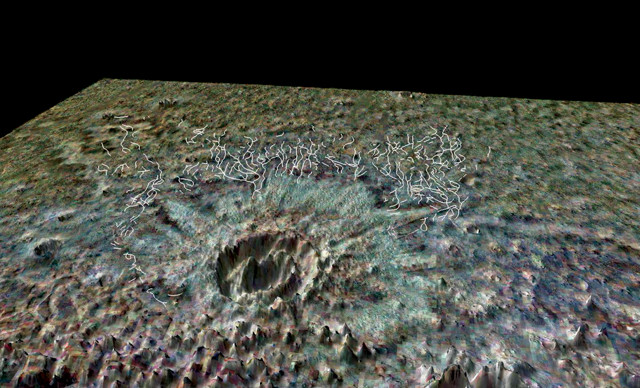
by Timothy Oleson Tuesday, September 19, 2017

A network of valleys, outlined in white, surrounds Lyot Crater in this computer-rendered illustration. New research suggests the water that carved these valleys likely melted from an ice sheet covering the area when an impact occurred. Credit: David Weiss/Brown/NASA.
With two rovers patrolling the surface of Mars, six spacecraft orbiting above it, and scientists here on Earth studying the Red Planet from afar, new findings are announced often. Here are a few of the latest updates.
A new study of Mars’ extensive ancient valley networks published in Nature Communications supports the idea that the planet had an active hydrologic cycle early in its history, and suggests that the volume of water needed to carve the valleys was far greater than previous estimates. Researchers developed a novel algorithm to analyze digital elevation model data planetwide, offering a more accurate picture of the scale of the valley networks compared to earlier analyses. Previous work had estimated total valley and water volumes based on selected localities and lower-resolution data. They reported that the minimum volume of Mars’ valleys and the amount of water required to carve those valleys are each “at least 10 times greater than most previous estimates,” noted lead author Wei Luo of Northern Illinois University, in a statement. “Water must have recycled through the valley systems on Mars many times, and a large open body of water or ocean is needed to facilitate such active cycling,” Luo said.
Although early Mars might have had a lot of water at its surface, it’s generally thought that since about 3 billion years ago, the planet has resembled the cold, dry place we know today. Because of that, a network of fluvial channels etched into the flanks of Lyot Crater, which is known to be younger than 3 billion years (although the exact age isn’t known), has puzzled scientists. In a study published in Geophysical Research Letters, David Weiss and colleagues at Brown University evaluated several competing theories explaining the Lyot valleys. The most likely, they suggested, is that the area struck by the crater-forming impactor was covered by an ice sheet at the time. The heat of that impact would have melted ice contained in rock excavated by the blast, and hot ejecta landing atop the ice sheet would have also caused melting. The presence of an ice sheet, estimated to have been between 20 and 300 meters thick, also explains the shortage of secondary craters surrounding the main crater that would have formed if debris had crashed directly back onto Mars’ surface, the team noted.
If the arid and frigid conditions aren’t enough, everyday soil constituents — when bathed with the usual dose of ultraviolet (UV) light streaming through the atmosphere — are likely to be highly lethal to any bacteria that might find their way to Mars’ surface, according to a new study in Scientific Reports. Jennifer Wadsworth and Charles Cockell of the University of Edinburgh in Scotland tested the resilience of the bacterium Bacillus subtilis, a hardy microbe commonly found in Earth soils and a known contaminant on spacecraft, to simulated Martian soils and UV light exposures. They found that the microbes were killed at twice the rate when chlorine-containing salts called perchlorates were present, confirming the suspected bactericidal effect of the salts, which have been detected in soils on Mars by NASA’s Phoenix lander and Curiosity rover. Furthermore, when the researchers added iron oxides and hydrogen peroxide — each also found in Martian soils — into the simulated, UV-drenched soil mixture, bacteria were killed nearly 11 times faster than with just perchlorates. The results suggest that Mars’ surface today is “more uninhabitable than previously thought, and demonstrate the low probability of survival of biological contaminants released from robotic and human exploration missions,” the researchers wrote.
© 2008-2021. All rights reserved. Any copying, redistribution or retransmission of any of the contents of this service without the expressed written permission of the American Geosciences Institute is expressly prohibited. Click here for all copyright requests.